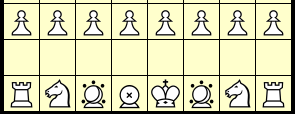Different Augmented Knights, NDvNF, game 1
Black's Knights are replaced by NF, that move either as a normal Knight or one square diagonally; White's Knights are replaced by ND, that move either as a normal Knight or jump two squares Rookwise, so that 1...NDg1-g3 is a legal move.Roytman - Betza, 1995, by email
1. d4 d5 2. Bg5 h6 3. Bh4 g5 4. Bg3 Bg7 5. NDb1-b3 Bf5 6. e3 e6?? 7. Bb5+ Kf8 8. NDg1-e2 NFg8-h7 9. Bd3 NFh7-g6 10. c4 NFb8-c6? 11. c:d5 e:d5 12. Rc1 B:d3 13. Q:d3 NFc6-b4 14. Qb5 NFb4-a6 15. Qa5 c6 16. Qa3+ Kg8 17. R:c6 Bf8 18. Qa4 Bb4+ 19. Kf1 b:c6 20. Q:a6 Qd7 21. f3 f5 22. a3 Bf8 23. NDb3-a5 Re8 24. Q:c6 Qf7 25. NDb5:a7 R:e3 26. NDa7-b5 NFg6-e7 27. Qd7 1-0
Note to 2. Bg5
Better get that in before you play Nf6! There's one big
advantage of your Knight - it's much less vulnerable to Bishop
attacks.
[After:] Now that the game is over, I can see that I certainly did not find the right answer!
Note to 4. Bg3
The Bishop occupies the useful g3 square, so the ND can't go there;
unfortunately, the Bishop is really good there, because it makes a
pin on c7!
Note to 5. NDb1-b3
From this square, the ND oppresses the whole flank, by threatening
to jump in at a5, b5, or c5. The convenient development here, with
consequent oppression, is one of the good points of the ND.
Note to 6...e6??
I should have taken back this move, perhaps in favor of NFb8-d7; I
thought I could afford to castle by hand, but I didn't
realize that the combination of the pinned Pawn at c7, the B at b5
(stalemating my NF on b8), and the oppressive ND at b3 would make
such a mess of my position so quickly.
I believe I played e6 because I was worried about Bd3. Things are very bad for me already. In fact, if I tried 6..NFb8-d7, how would I answer NDb3-b5!, attacking both c7 and b7? Is 6...a6 forced? What a bad game I have, and so early in the opening!
Note to 9..NFh7-g6
After much squirming, at last I have found an answer to Bd3.
Unfortunately, worse things are about to happen.
Note to 10..NFb8-c6?
This move defends against both 11 NBb3-b5 (NFc6:b5) and 11 NDb3-c5
(B:d3 12 Q:d3 NFc6-b4 and 13...NFb4:c5). However, I didn't see Rc1
coming...
- I just realized that Nf8 18. Qa4 Nb4 19. Rc3 a6 (...b5 trap Q) - may not work because Rc3 not required because Nb3 defends d3. - This may require a j'adoube of ...c6, which seems to have been deep - but wrong; or maybe I just go ahead with Bf8 and Bf4+, who knows? - Come to think of it, Bf8 18. R:a6 might be interesting. I was wondering when you'll start talking about j'adoubing :-) Perhaps 13. N:d3 would have been better for me; also, I could have played 14. Qd2; 10..Nc6 was probably the worst move in the whole sequence, though.
The rest is silence because I can't stand it!
On the other hand, please do look at the rest of the moves, and see how powerful the ND is, and how hopelessly weak the NF is; and then go to this game, and see just the opposite!
The Players:
Ralph Betza holds the title of FIDE master.Vladimir Roytman is a USCF National Master.
We need a certain number of lines after the last jump, so that the browser will be sure to put the jump right at the top of the screen.
Other Links In these Pages
- Top
- Chess with Different Armies
- Chess Variants with Different Armies
- Index to Chess Variants
- Index to Different Augmented Knights
- Index to Games of Different Augmented Knights
- About the Values of Chess Pieces
- Copyright Ralph Betza 1996
